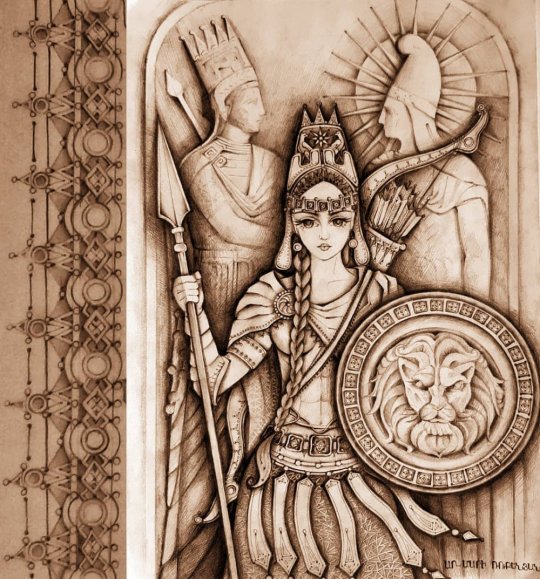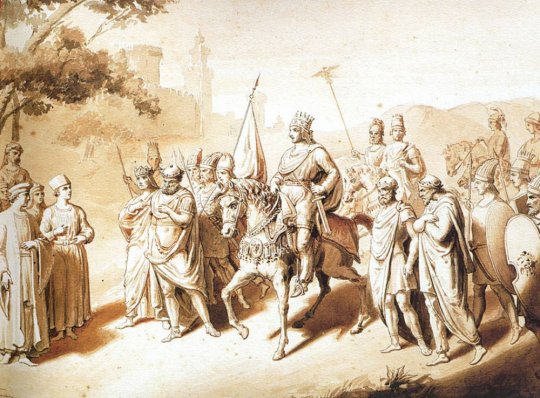

საზოგადოებრივი არმენები 2019, 21 ივლისი, 20:28 
არმენები, რომლებსაც მხოლოდ ქართველები უწიდებენ სომხებს, სამხრეთ კავკასიის ტერიტორიაზე პირველად ჩნდებიან ძვ.წ. VI საუკუნეში და სწორედ ამ პერიოდიდანვე მოიხსენიებიან ძველბერძნულ (ჰეკატეოს მილეტელი, ჰეროდოტე) და სხვა საისტორიო წერილობით წყაროებში. არმენიელების შემოსვლა სამხრეთ კავკასიაში მოხდა მას შემდეგ, რაც ალაროდიელები, იგივე ურარტუელები (ბაიანელები) ძალიან დაასუსტა და სახელმწიფო გაუნადგურათ სკვითების შემოსევამ და საბოლოოდ ძვ.წ. 590 წელს ბოლო მოუღო მიდიის სამეფომ. სწორედ ამ პერიოდში შემოდიან დამარცხებული ურარტუელების მიწებზე არმენები და ახდენენ მათთან ასიმილაციას, რაც არმენიის წარქმნით სრულდება, რომელსაც ასევე არმენი განმგებლები მართავდნენ და მართავენ დღემდე. ჰეროდოტე (ძვ.წ. 484-425) წერს: ფრიგიელების მეზობლად არიან კაპადოკიელები, რომელთაც ჩვენ სირიელებს ვუწოდებთ, ხოლო ამათი მეზობლები არიან კილიკიელები... კილიკიელების მეზობლად არიან არმენიელები, ხოლო არმენიელების მეზობლად არიან მატიენები, რომელთაც ეს ქვეყანა უჭირავთ." (ჰეროდოტე, 1975, გვ.330, V, 49). შდრ. იქვე გვ. 434: "ფრიგიელებს, როგორც მაკედონელები ამბობენ, ეწოდებათ ბრიგები, მთელი იმ ხნის განმავლობაში, სანამ ევროპელები იყვნენ და მაკედონელების მეზობლად ცხოვრობდნენ, ხოლო აზიაში რომ გადავიდნენ, მიწა-წყალთან ერთად, სახელიც გამოიცვალეს - ფრიგიელები დაირქვეს. არმენიელები, რომლებიც ფრიგიელებისგან მომდინარეობენ, ფრიგიელების მსგავსად იყვნენ მოწყობილნი." 
დიოდორე სიცილიელის მიერ ჩამოთვლილი ტომების თანმიმდევრობა (ძვ.წ. I ს.): კარდუხები, არმენიელები, ხაები (ე.ი. ტაოხები), ფასიანები, ხალდები, სკიტინები, მაკრონები, კოლხები, მოსინიკები, ტიბარენები (თ. ყაუხჩიშვილი, 1976, გვ. 124). იპოლიტე რომაელი (III ს.) წერს: "კაპატუკიელთა გადაღმა, მარჯვენა მხარეებში ცხოვრობენ არმენიელები, იბერიელები და ბერანები, ხოლო მარცხენა მხარეებში სკვითები, კოლხები და ბოსპორელები." (გეორგიკა, 1961, გვ. 19). ძვ.წ. II საუკუნეში არმენები დიდ წარმატებებს აღწევენ. 
ივანე ჯავახიშვილის აზრით (1960, გვ. 437), რამდენადაც ქსენოფონტე (ძვ.წ. 427-355) არაქსის მიდამოებში ალაროდების ნაცვლად უკვე არმენებს ასახელებს, შესაძლებელია ვიმსჯელოთ ამ ტომის კავკასიაში მოსვლის შედარებით ზუსტ თარიღზეც. ჩვენთვის სავსებით სარწმუნოა სამეცნიერო ლიტერატურაში გაბატონებული აზრი, რომ ეთნონიმი "სომეხი" თავდაპირველად ერთი განაპირა ქართველური ტომის ან თუნდაც მონათესავე ურარტუელების სახელი იყო. ჩანს, საუკუნეების მანძილზე თანდათან დამკვიდრებულმა არმენებმა ნელ-ნელა მოახდინეს ურარტულ-ქართველურ ტომთა (იბერო-კავკასიელების) ასიმილაცია. ასიმილირებული ქართველური ტომის მეტყველების დანაშრევი აშკარაა როგორც არმენიელთა ენაში (კავკასიური აბრუპტივების რიგის არსებობის ფაქტი), ასევე მათს ანთროპოლოგიურ მახასიათებლებში (ეს ჩანს ასევე გენეტიკური სეკვესტრირებით მიღებულ მონაცემებში). შემთხვევითი არ ჩანს ის, რომ არარატის ძველი სახელი - მასის მთა და ეთნონიმი "სომეხ-ი" (<*სო-მესხ, <* სა-მასხ). ერთმანეთთან დააკავშირა ნიკო მარმა. საკითხი შემდგომ კვლევას საჭიროებს. სამეცნიერო ლიტერატურაში მსჯელობენ არმენებისა და სკვითების საერთო წარმომავლობის შესახებ (ნ. ხაზარაძე, 1984, გვ.194), სარწმუნოა მოსაზრებაც, რომ ჰაიკი კავკასიაში მოსახლე (ავტოქტონი), ურარტულ-ხურიტული მოდგმის ხალხის ეთნარქია, ხოლო არმენიაკი - მოსული ინდოევროპელებისა, სკვითებისა. მოხდა ავტოქტონი და მოსული ხალხის შერწყმა (მ. სანაძე, 2001, გვ.42-43). (წყარო: ტ. ფუტკარაძე, "ქართველები", 2005). კრებულები:1. ქართველური ტომები2. ქართული სახელმწიფოები3. იბერო-კავკასიური პროტოცივილიზაციები4. ქართული მითოლოგია5. საქართველო6. ნაციზმი7. ჰიტლერი8. მეცნიერება9. რელიგია10. პარანორმალიავტორი: თორნიკე ფხალაძე1664 2-ს მოსწონს 1-ს არა |
Armenians, first appeared on the territory of the South Caucasus from VI century BC. They are mentioned in the South Caucasus in the 6th century BC and from this period in ancient Greek (Hecataeus of Miletus, Herodotus) and other historical written sources. The entry of the Armenians into the South Caucasus took place after the Alarodians, the same Urartians (Biainilians) were very weakened and the state was destroyed by the invasion of the Scythians and finally by the kingdom of Media destroyed the strength of Urartu In 590 BC. It was during this period that the Armenians entered the lands of the defeated Urartians and assimilated with them, culminating in the formation of Armenia. Herodotus (484-425 BC) wrote: Phrygians are next door to the Cappadocians, who we call Syrians, while their neighbors are Cilicians... Cilicians are next door to Colchis and Mattians, then there are Armenians, who occupy this land." (Herodotus, 1975, p.330, V, 49).
"The Phrygians as Macedonians, They are said to be called Briges , as long as they were Europeans and lived next door to the Macedonians, and when they moved to Asia minor, along with land, they also changed their name and they were called Phrygians. The Armenians, who are descended from the Phrygians, were organized like the Phrygians." (Herodotus, 1975, page 434).
According to a legend first reported by Eusebius in the fourth century, King Abgar V (Abgar V Ukkama bar Ma'nu (Abgarus of Edessa) (4 BC–AD 7) was converted by Thaddeus of Edessa, who was one of the seventy-two disciples, sent to him by "Judas, who is also called Thomas". However, various sources confirm, that the Abgar who embraced the Christian faith was Abgar IX (Abgar (XI) Farhat Bar Ma’nu (IX) (AD 242–244). Under him Christianity became the official religion of the kingdom.
Agatangelos (Armenian: Ագաթանգեղոս) is a 5th century Armenian historian. In his "History" he describes the Christianization of Armenia (beginning of IV century), the organization of the Armenian Church and conveys the principles of Christianity. He describes the stories he calls as modern for himself, but in fact he wrote them in the second half of the 5th century. He was not even born when Armenia was Christianized. Consequently, he is lying here and there is reason to doubt other information written by him.
He claims that Armenia was converted to Christianity in 301. Let's
Follow the events and analyze the situation. In 301, the Kingdom of Armenia (331 BC - 428 AD) was ruled by King Tiridates III (reign 287–330 AD). Throughout his reign, the Kingdom of Armenia was officially under Roman protection, independent but largely controlled - It was a Roman protectorate.
The second important circumstance also contradicts the statement of Agathangelos. In particular, the life of St. Nino, which sheds more light on the current situation. St. Nino was born in 286 in Capadoccia. She came to Iberia in 317. Nino had previously lived in the eastern part of the Roman Empire, ruled by Licinius, a persecutor of Christians in 313-324. The Blessed Virgin Nino and her friends escaped the persecution of Licinius in Armenia, where they came on March 15, 317 ("the first fifteenth of the month"; March was considered the first month of the year in the Roman Empire), and were martyred on March 30 in the garden of King Tiridat III. Of the virgins, only Nino survived, hiding in the rose bushes. There she heard the voice of the Lord, saying, "And thou shalt rise up and go toward the east, wherein there is plenty of grain, and there are no laborers at all."
Polygamy was forbidden to the early Christians. Since Tiridat offered Hripsime to become his second wife, so, he wanted to have many wives. As it seems, Tiridat III was not a Christian for 317 AD. In general in any part of the world, the first people to convert to Christianity were a true believers. They believed like fanatics. They did not look like the already depraved Middle Ages. Person accepting a new religion because he/she believed so much. If Tiridat wanted to have polygamy and to torture people, then why would he accept Christianity at all, and why would he oppose the supreme power of Rome in 301 because of Jesus' name?
The third important fact is that the first ecclesiastical assembly in the world was held in Nicaea in 325 AD. The main purpose of the meeting was to issue a formal resolution on Christianity as a state-recognized religion.
Agatanghelosis notices, that Armenia was the first country which recognized Christianity as the state religion in 301 can be considered false for the following reasons:
1. the first Christian kings and generally, the first Christians were the true believers and Tiridat III, who was the king, who first Christianized Armenia, would not torture and kill dozens of Christian women. Nor would he want polygamy.
2. Tiridat III was an obedient ruler of Rome and could not and would not go against Roman Empire, that was persecuting Christians and Christianity for that time, and would not and could not accept it as the state religion for 301.
3. Dates do not match - St. Nino enters in Georgia (Kingdom of Iberia) in 317, surviving death and persecuted by Tiridat III of Armenia.
4. The First World Council of Churches is held in 325 in Nicaea, where the idea and rules for the proclamation of Christianity as the state religion are adopted.
აგათანგელოსი (სომხ. Ագաթանգեղոս) — V საუკუნის სომეხი ისტორიკოსი. თავის „ისტორიაში“ აღწერს სომხეთის გაქრისტიანებას (IV საუკუნის დასაწყისი), სომხური ეკლესიის ორგანიზაციას და გადმოსცემს ქრისტიანობის პრინციპებს. თავს აღწერილი ამბების თანამედროვედ აცხადებს, სინამდვილეში კი V საუკუნის მეორე ნახევარში წერდა. ის დაბადებულიც კი არ იყო მაშინ, როცა სომხეთი გაქრისტიანდა. შესაბამისად აქ განგებ იტყუება და მის მიერ დაწერილ სხვა ინფორმაციაშიც ეჭვის შეტანის საფუძველი არსებობს. ის აცხადებს, რომ სომხეთი 301 წელს გაქრისტიანდა.
მივყვეთ მოვლენებს და გავაანალიზოთ ვითარება. 301 წელს სომხეთის სამეფოს (331 BC – 428 AD) მართავდა მეფე - თრდატ III (Tiridates III - 287–330 AD). მისი მმართველობის მთელი პერიოდის განმავლობაში არმენიის სამეფო იყო ოფიციალურად რომის მფარველობის ქვეშ, დამოუკიდებელი, მაგრამ დიდწილად კონტროლირებული რომის ცენტრალური ხელისუფლების მიერ (Roman protectorate). რომის იმპერია ახ.წ. 301 წლისთვის ატარებდა მკვეთრად ანტიქრისტიანულ პოლიტიკას. იდევნებოდნენ ქრისტიანები იმპერიაში და ვერცერთი რომის იმპერიის გავლენის ქვეშ მყოფი მმართველი ვერ გაბედავდა ქრისტიანობის ოფიციალურად აღიარებას, ძალიანაც რომ სდომოდა ეს, ვინაიდან მწარედ დაისჯებოდა რომის მიერ.